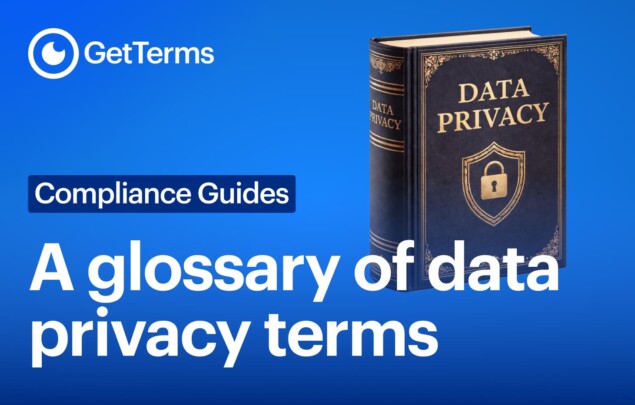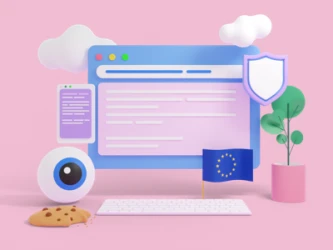A Glossary of Data Privacy Terms
Key definitions in global privacy regulations in plain English

Create a GDPR-ready Privacy Policy, Terms & Cookie Banner in under 5 minutes.

The implementation of cookie consent banners on websites has become not just a legal requirement in many countries but a crucial aspect of user trust and transparency. As users become more aware of their digital rights, website owners and developers must adopt best practices in presenting cookie consent banners. In this article, we delve into creating a tailored cookie consent banner that not only complies with regulations but also enhances the user’s experience.
Scan your website cookies and create a cookie consent widget in 5 minutes.
Get StartedBefore diving into best practices, let’s establish a foundational understanding of cookies and the regulations governing their usage. Cookies are small text files stored on a user’s device, containing information about their online activity. The General Data Protection Regulation (GDPR) and other privacy laws mandate websites to obtain user consent before placing cookies on their devices.
The intricate dance between personalized online experiences and user privacy has given rise to the need for transparent communication. Cookie consent banners serve as the gateway, providing users with insights into data collection practices and affording them control over their digital footprint.
Why it Matters: Transparency breeds trust. The messaging within your cookie consent banner should be crystal clear, avoiding jargon and conveying the benefits of cookies in a language that resonates with your audience.
Best Practice: Articulate concise and compelling messages that not only explain the necessity of cookies but also highlight the enhanced user experience they facilitate, such as personalized recommendations or a streamlined shopping journey.
Why it Matters: One size rarely fits all. Users appreciate the ability to tailor their privacy settings. Offering customization options within the banner empowers users to align cookie preferences with their comfort levels.
Best Practice: Implement a user-friendly preference center directly within the banner. Allow users to select the types of cookies they consent to, be it for analytics, advertising, or fundamental site functionalities.
Why it Matters: Visibility without intrusion is an art. Placing the cookie consent banner strategically and designing it to complement your website’s aesthetics ensures user attention without disrupting their journey.
Best Practice: Position the banner prominently, ideally at the top or bottom of the page, with colors harmonizing with your website’s design. Make it noticeable yet seamlessly integrated into the overall aesthetic.
Why it Matters: Transparency is the bedrock of trust. Detailed information about each cookie type, easily accessible from the banner, allows users to make informed decisions about their privacy preferences.
Best Practice: Include a direct link to a comprehensive cookie policy within the banner. Break down each cookie’s purpose, the data it collects, and the entities involved in a user-friendly manner.
Why it Matters: Mobile users are a significant demographic. Ensuring the banner is optimized for various screen sizes guarantees a consistent and user-friendly experience.
Best Practice: Prioritize responsive design, ensuring the banner looks visually appealing and functions seamlessly on a variety of devices. Test across different screen sizes to guarantee a uniform experience
Why it Matters: First impressions count. Delaying the loading of non-essential cookies allows users to explore your site before committing to privacy decisions.
Best Practice: Initiate with loading only essential cookies. Offer users the option to consent to non-essential cookies after they’ve engaged with your site or during key interaction points.
Why it Matters: Inquisitive users seek information. Providing direct links to comprehensive privacy policies within the banner adds an extra layer of transparency.
Best Practice: Ensure a clear link to the privacy policy is embedded in the banner. The privacy policy should cover every aspect of data collection, processing, and storage for thorough user understanding.
Why it Matters: Websites are dynamic entities. Regularly updating the cookie consent banner ensures users are informed about any shifts in cookie policies.
Best Practice: Institute periodic reviews of the banner, especially after significant website updates or shifts in data processing practices. Communicate updates transparently to maintain user trust.
Why it Matters: Regulations are dynamic. Staying ahead of the curve ensures your website aligns with the latest legal standards, fostering a culture of trust and accountability.
Best Practice: Stay informed about privacy regulations such as GDPR, CCPA, or any regional laws pertinent to your audience. Consult legal experts to ensure continuous and proactive compliance.
The art of crafting an effective cookie consent banner extends beyond compliance—it’s about establishing a relationship of trust with your users. By integrating these best practices into your approach, websites can seamlessly navigate the multifaceted landscape of privacy expectations and legal requirements. A user-centric focus not only aligns with the values of today’s discerning consumers but also positions your website as a steward of transparent data practices, a key differentiator in the competitive digital landscape. Elevate user trust, foster compliance, and pave the way for sustained success in the ever-evolving realm of online privacy.
Scan your website cookies and create a cookie consent widget in 5 minutes.
Get Started